Panache
International Hazard
    
Posts: 1290
Registered: 18-10-2007
Member Is Offline
Mood: Instead of being my deliverance, she had a resemblance to a Kat named Frankenstein
|
|
Very odd piece of high precision glass, any ideas?
One end is completely sealed with making liquid filling a challenge, the upper part has an internal tube which at its base has a fine platinum wire
sealed through it. it is difficult to photograph the fine wire.
It is very beautiful and obviously has a specific function
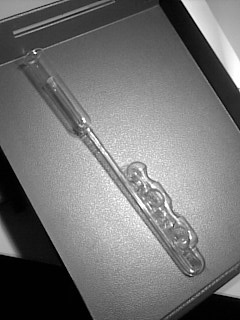 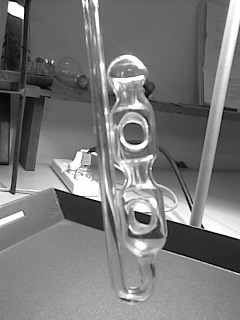 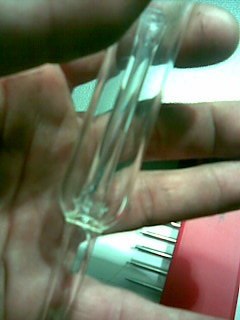
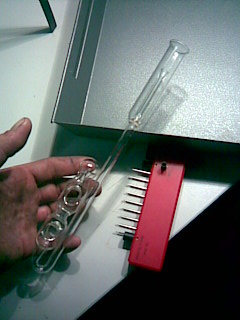
|
|
|
chief
National Hazard
   
Posts: 630
Registered: 19-7-2007
Member Is Offline
Mood: No Mood
|
|
It might be some sort of a temperature-controller, the way a contact-thermometer works:
==> The double-strange shape at the bottom is designed to contain gas, up to a certain height (for eventually rising liquid), but is limited in the
volume ...
--> ... it contains about as much volume as the straight part of the thing ...
==> The upper part is designed to take potentially all the liquid from below, into the wider outer tube, without spilling anything over the place ;
the platinum-wire gives a physical aspect ...
==> Also it's pretty much non-chemical glassware, since it just would be throwaway-uncleanable ...
---------------
Probably for measuring deep temperatures or regultating deep-temperature processes ...
===========
If the straight part would have some scaling it might be useful as araeometer, adjustable with different sorts of fillings ...
|
|
|
Panache
International Hazard
    
Posts: 1290
Registered: 18-10-2007
Member Is Offline
Mood: Instead of being my deliverance, she had a resemblance to a Kat named Frankenstein
|
|
Thanks chief, your guesses regarding the volume's are spot on so likely you are right about its purpose, however what do you mean by 'the platinum
wire gives it a physical aspect?
ok more glass to try to decipher, the fifth and sixth photo are of a absolutely amazing thing, it is essentially a fishing rod for a vacuum setup, the
little rod seen in the second photo has a spool of super fine filament spun around it, so i guess it for lowering something into something whilst the
system is under vacuum, as the joints were heavily greased when i got it.
Any ideas on it's use, it extremely well made and has a small eyelet in the b34 joint to guide the line down such that it remains centered.
Photo 1 and 7 are a still head but with an interesting addition, the coil the leads from the stillhead has two platinum inserts, one at the top of the
coil and one at the bottom. I guess once the coil is full of liquid and either distilling or reluxing you could possibly achieve a resistance reading
over the length of fluid in the coil.
Any other ideas?
Photo 2 and 3 are of the most unusual condenser i have come across. It is very large (B50 socket at bottom), however the cooling surface is like a
upside down dry ice condenser, so essentially the gas to be cooled would be sucked into a dead end zone by the reduced pressure within the large
upside down cooled cavity, condensed and thus ensuring the pressure drop continues as such, it seems very efficient when i have used it although i
haven't hit it hard yet.
Any ideas as to its designed use?
Lastly photo 4 is of a factory item that for all i can guess is some sort of glass eye wash basin, male ground glass at the bottom with feeds through
to a female joint within the basin section, the basin section drain out via a simple barbed joint.
Any ideas on this one.?
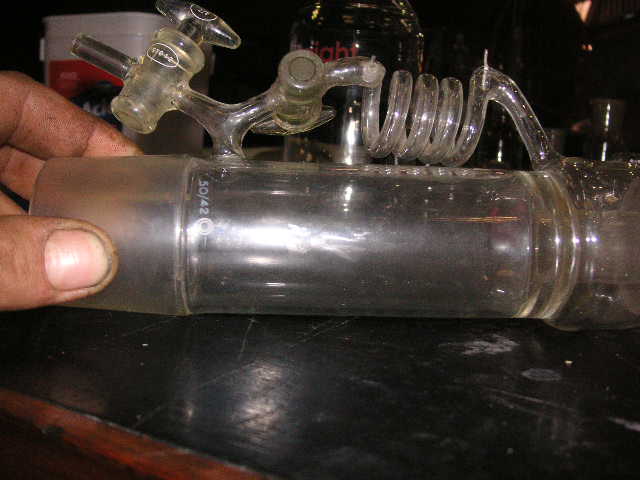 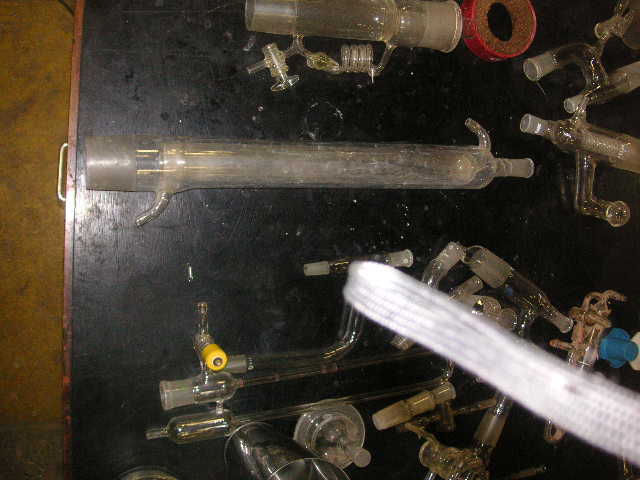 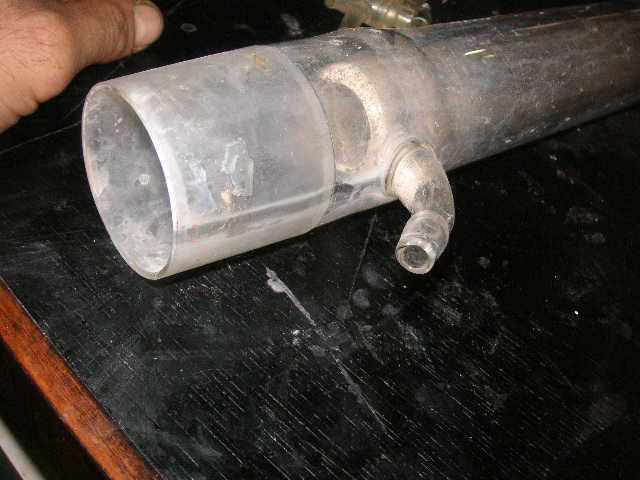 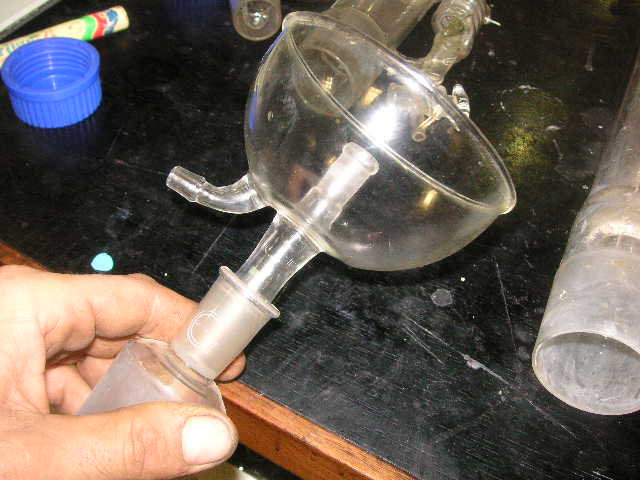 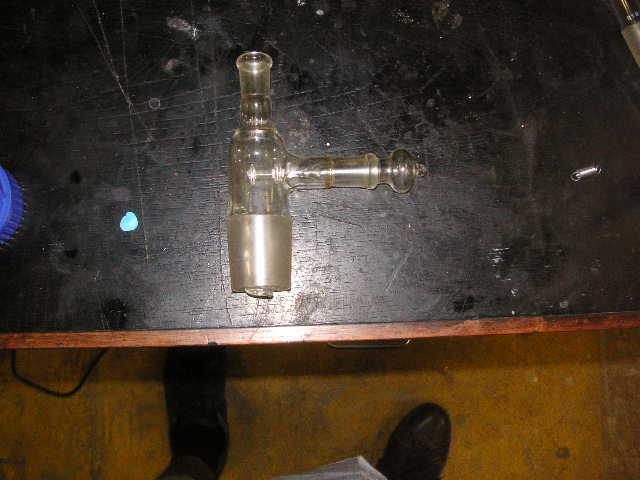 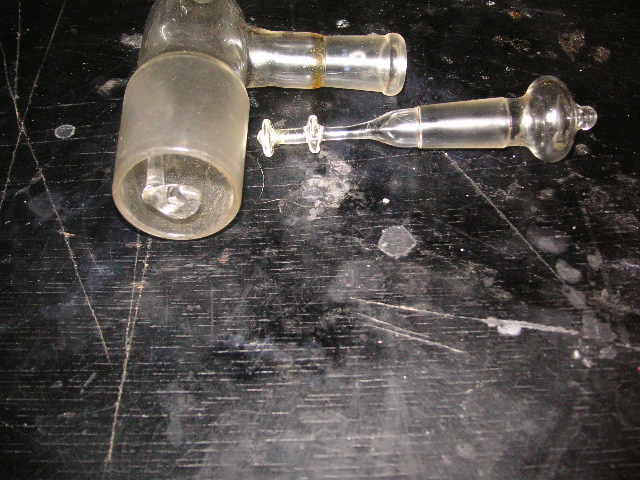 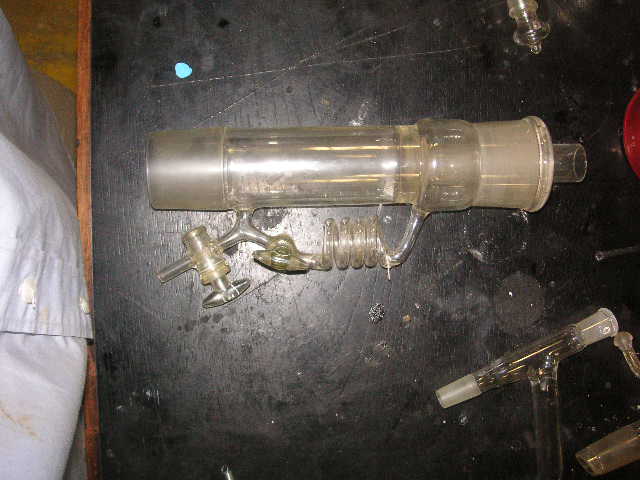
[Edited on 31-3-2010 by Panache]
|
|
|
Skyjumper
Hazard to Self
 
Posts: 93
Registered: 1-3-2010
Location: Assachusetts
Member Is Offline
Mood: Refluxing
|
|
I am wondering if number 2 is a reflux for a large flask, and the idea is that the top isnt really used for anything (a vent to avoid pressure build
up)
|
|
|
not_important
International Hazard
    
Posts: 3873
Registered: 21-7-2006
Member Is Offline
Mood: No Mood
|
|
Re 1-7, not resistivity so much as conductance - "yes, the tube is full of liquid". Does the arm of the 'Y' connected to the body drain into the
lower joint?
Exactly what is going on in the lower portion of 2-3, that region shown in 3?
|
|
|
Panache
International Hazard
    
Posts: 1290
Registered: 18-10-2007
Member Is Offline
Mood: Instead of being my deliverance, she had a resemblance to a Kat named Frankenstein
|
|
Quote: Originally posted by not_important  | Re 1-7, not resistivity so much as conductance - "yes, the tube is full of liquid". Does the arm of the 'Y' connected to the body drain into the
lower joint?
Exactly what is going on in the lower portion of 2-3, that region shown in 3?
|
yes the y drains to the lower joint so depending on how you configure the taps you can reflux or distill.
re 2,3 i see the photo's now are fairly crappy, basically its a large tube, however inside the tube is a condensing surface designed quite unusually.
At the lower end where the large male socket is begins what can only be described as an upsidedown cup, open at bottom sealed at the top, it is double
skinned and the cooling water flows through this 'cup' to produce the condensing surface.
To explain further, gas flowing from the vessel into the male join, has a choice of two paths, either up the gap that exists between the wall of the
tube and the outer condensing surface of the 'cup', this path carries on up the tube and around the top of the cup and out through the smaller female
socket at the top.
The other path the gas could take is into the body of the inverted cooled cup, ordinarily one would expect little to no vapour flow into a dead end
path when a through path is available, however as the cup is cooled, assuming your gas is condensable, vapour would initially flow into the cup,
condense, causing a pressure drop thus drawing more vapouir into the cup, the condensed liquid runs back down the cup and out the male socket.
i'll try a better photo
|
|
|
UnintentionalChaos
International Hazard
    
Posts: 1454
Registered: 9-12-2006
Location: Mars
Member Is Offline
Mood: Nucleophilic
|
|
Together, photos 2 and 3 look like a solvent purification still, but without much of a reservoir. The need for the coiled piece of glass is beyond me,
but refluxing THF with sodium/benzophenone and then swapping stopcocks to collect distilled, dry solvent from the tap would make sense. The odd shape
of the condenser may be to prevent liquid from dripping back down the "vapor conduit" (the tube rising from the top of the thing in picture 2, which I
imagine projects into the center of the "cup." Vapor that does not condense here has a very long way to go over the outside before it might escape
from the top joint, resulting in very high efficiency. The top joint is probably just pressure release, I imagine. Add a drying tube or balloon of
inert gas there.
Compare with this somewhat less archaic looking piece of glass: http://www.wilmad-labglass.com/prodart/3575.gif http://ecx.images-amazon.com/images/I/41H4dlj5VCL._SS500_.jp...
The "vapor conduit" has been shaped so condensate from a condenser in the upper vertical joint drips down onto it, but rolls off into the collection
flask. The lower sidearm's stopcock is fitted with a T-bore plug, allowing you to either drain back into the flask for reflux or to drain to a
reaction flask with a ground glass joint of your choosing (such as a schlenk). I believe that the upper stopcock is either for an inert gas/vac feed
or sampling, but I've never used one before.
[Edited on 4-1-10 by UnintentionalChaos]
Department of Redundancy Department - Now with paperwork!
'In organic synthesis, we call decomposition products "crap", however this is not a IUPAC approved nomenclature.' -Nicodem
|
|
|
Panache
International Hazard
    
Posts: 1290
Registered: 18-10-2007
Member Is Offline
Mood: Instead of being my deliverance, she had a resemblance to a Kat named Frankenstein
|
|
Quote: Originally posted by UnintentionalChaos  | Together, photos 2 and 3 look like a solvent purification still, but without much of a reservoir. The need for the coiled piece of glass is beyond me,
but refluxing THF with sodium/benzophenone and then swapping stopcocks to collect distilled, dry solvent from the tap would make sense. The odd shape
of the condenser may be to prevent liquid from dripping back down the "vapor conduit" (the tube rising from the top of the thing in picture 2, which I
imagine projects into the center of the "cup." Vapor that does not condense here has a very long way to go over the outside before it might escape
from the top joint, resulting in very high efficiency. The top joint is probably just pressure release, I imagine. Add a drying tube or balloon of
inert gas there.
Compare with this somewhat less archaic looking piece of glass: http://www.wilmad-labglass.com/prodart/3575.gif http://ecx.images-amazon.com/images/I/41H4dlj5VCL._SS500_.jp...
The "vapor conduit" has been shaped so condensate from a condenser in the upper vertical joint drips down onto it, but rolls off into the collection
flask. The lower sidearm's stopcock is fitted with a T-bore plug, allowing you to either drain back into the flask for reflux or to drain to a
reaction flask with a ground glass joint of your choosing (such as a schlenk). I believe that the upper stopcock is either for an inert gas/vac feed
or sampling, but I've never used one before.
[Edited on 4-1-10 by UnintentionalChaos] |
Yes, it all makes sense now, it only looks archaic as it was soiled, apparently some lab flooded with river water from the Maribynong River (a heavily
polluted silted large metropolitan creek) and they wrote the entire lab off because everything was covered in mud, my glass blower bought the lot and
i buy random boxes off him (dirty of course).
|
|
|
chemrox
International Hazard
    
Posts: 2961
Registered: 18-1-2007
Location: UTM
Member Is Offline
Mood: LaGrangian
|
|
The first item shown looks like a task in glassblower training.. the rest do seem to be related to solvent recycling. I picked some odd batches from
ebay because they were cheap. Both lots were wasted space and shipping costs.
"When you let the dumbasses vote you end up with populism followed by autocracy and getting back is a bitch." Plato (sort of)
|
|
|
JohnWW
International Hazard
    
Posts: 2849
Registered: 27-7-2004
Location: New Zealand
Member Is Offline
Mood: No Mood
|
|
Where did you get that elaborate piece of laboratory glassware from, Panache? Surely not in Saudi Arabia? What do you know about its history or
provenance?
|
|
|
DJF90
International Hazard
    
Posts: 2266
Registered: 15-12-2007
Location: At the bench
Member Is Offline
Mood: No Mood
|
|
Could the platinum electrode type things in the coil of picture 1 be used for determining water content of dry solvents by conductivity? (If it is
some kind of solvent stillhead that is?)
|
|
|
Panache
International Hazard
    
Posts: 1290
Registered: 18-10-2007
Member Is Offline
Mood: Instead of being my deliverance, she had a resemblance to a Kat named Frankenstein
|
|
Quote: Originally posted by JohnWW  | | Where did you get that elaborate piece of laboratory glassware from, Panache? Surely not in Saudi Arabia? What do you know about its history or
provenance? |
Which piece JohnVW?
---->Could the platinum electrode type things in the coil of picture 1 be used for determining water content of dry solvents by conductivity? (If
it is some kind of solvent stillhead that is?)
Nice call, i'm going to look into that.
|
|
|
DJF90
International Hazard
    
Posts: 2266
Registered: 15-12-2007
Location: At the bench
Member Is Offline
Mood: No Mood
|
|
Could you perhaps take clearer pictures of that specific item? I can't see if there's a reservoir or where the side arms actually lead too properly;
if it resembles a solvent still in this respect then I suspect my above suggestion could be quite possibly correct.
|
|
|
chief
National Hazard
   
Posts: 630
Registered: 19-7-2007
Member Is Offline
Mood: No Mood
|
|
The platinum electrode could be for connecting/disconnecting the liquid from some circuit ...
Since it's only _one_ electrode the thing would work capacitically, the entire thing hanging within some other liquid, the glass forming the
dielectricum ..., and another electrode hanging in the outher "bath" ...
It would work as a temperature-regulator like this:
==> Within the tubing a somehow-conducting liquid with the right boiling-point would reside ...
==> and whenever this boiling-point would be reached the liquid would be driven up by gases formed in the strange-shaped lower part), connencting
the liquid to the electrode ...
===> ... thereby connecting the "capacitor" to some circuit, which would switch off the heating so long as the liquid would stay connected ...
By various filling-liquids for the thing a fixed temperature could be regulated quite easily and reliably ...
======================
Another way for using it would be to measue the capacitance of the formed capacitor:
==> In this case the filing-liquid would not boil, but only the gase in the stange part would drive the liquid more or less up the tube ...
===> thereby varying the capacitance, which could be measured for getting the temperature ...
As is known in deep-temperature-busines it's possible, but not the best idea, to measure those temperatures with thermal resistors, since those
produce heat,
==> and the thermal capacity of things gets quite low at low temperatures ..., which means the things get heated up just by the current that is
flowing through the resistor for measuring-purposes ...
Also the expansion of a gas gives a much cleaner curve at low temperatures, because phase-changes are absent ...
==> ... can easily be "corrected" with a simple polynome to get to the temperature ...
======================
So this may well be a device either for deep-temperature-measuring or as a quite simple temp-controlling-aid ... from the pre-electronic era ...
|
|
|